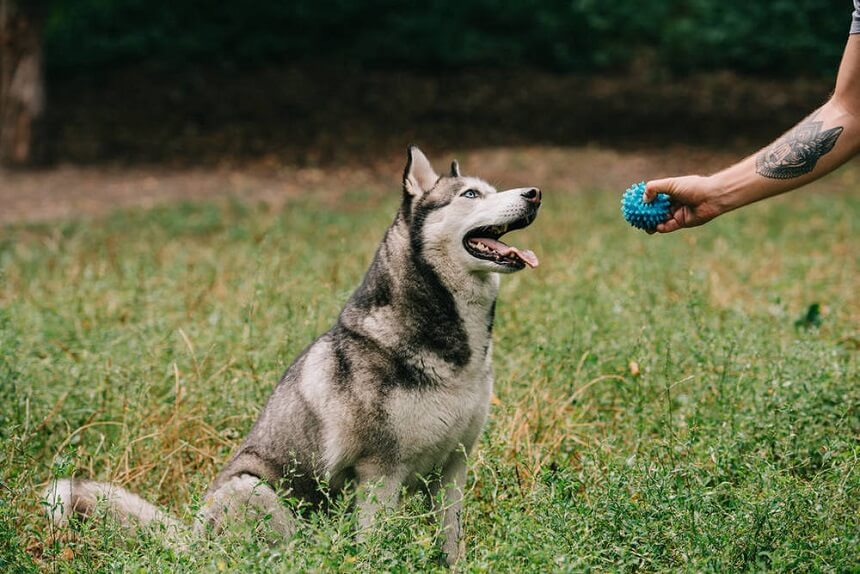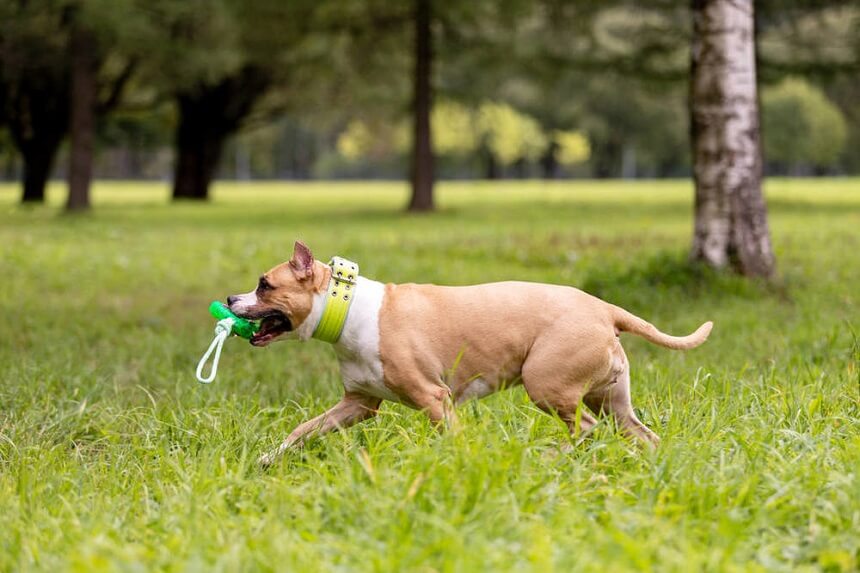6 Quick Tips To Mastering How To Train Your Dog To Fetch
Quick View
How to Train Your Dog to Fetch?
Wondering how to teach a dog to fetch a frisbee, ball, or plush toy? Teaching dogs to fetch is excellent, as fetch is a fun and relatively low-effort exercise that allows you to strengthen your bond with your dog. Dogs that play fetch are also healthier, more alert.
Prepare for Dogs Before Teaching
Before teaching a dog fetching, you must prepare it appropriately. Not all dogs are instinctive fetchers, and teaching dogs to fetch reliably on command is a lot more than just ball training dog.
To teach dogs to fetch, you must get them the right fetch toys, build interest in them, and plan out a training regime. Set your dog up for success by carrying out the training sessions in small, easy-to-digest chunks.

At What Age Can You Teach a Puppy to Fetch?
Eight to twelve weeks of age is the perfect time to teach dogs to fetch, but you must keep their age and abilities in mind and alter the intensity of the training accordingly.
Ball training in dogs is particularly beneficial as it’s not only a great way for you and your pet to bond, but it also relieves anxiety, enhances mood, and improves behavior. Puppy fetch games also stimulate your dog mentally and can be a great way to de-stress after a long day at work.
6 Steps To Teach A Dog To Fetch
Training dogs to fetch can be a long and tiring process, but dog fetch ball also makes a great bonding opportunity for you and your dog.
Follow the guide below to teach your dog to fetch and be patient and kind throughout for the best results.
1. Select a dog fetch toy
The first step in ball training your dog is obviously to select a suitable fetch toy for it. Fetch toys can vary dramatically in size and are made from a number of different materials like rubber, plastic, yarn, etc.
Choose toys keeping your dog's age, size, and ability in mind, and get multiple toys to have some variety and better determine what type your dog likes. Click Here to urge a broad range of fetch toys for your dogs!
Popular fetch toys like tennis balls, squeaker balls, bumpers, frisbees, and plushies are generally good choices. However, you should be careful about the materials used and avoid anything too hard if your dog has dental problems. Also, be sure to stick to things that are easy to hold when first teaching your dog to fetch.

2. Get your dog interested in the toy
Once you buy your dog some fetch toys, you must get it actually interested in said toys. One of the best ways to do this is to show interest yourself. Be excited about the toy when you introduce it, and your dog will inevitably become excited too.
In case of plush, rope, or bumper toys, you can further build interest by teasing your dog with the new toy before playing tug-of-war with it and letting your dog explore it once it takes it from you. Be sure to reward your dog for interacting with the toy at this stage, and even put treats inside the toy if possible.
3. Train it to hold the toy
Another important step in teaching dogs to fetch is teaching them to actually hold the toy in their mouth. While all dogs naturally hold things in their mouths, they need training to actually do so on command or for longer periods of time.
To train your dog to hold the toy, start by rewarding it for putting it in its mouth. Slowly increase the time duration between your dog holding the toy in its mouth and you rewarding it until it can successfully hold the toy for a couple of seconds. Next, introduce a verbal command like 'hold' and continue to build tolerance.
The reward can be anything ranging from clicks to praise to actual treats, and you can also put a treat inside the toy to make hold training easier.

4. Encourage chasing the toy
Place the toy on the ground and have your dog hold it, rewarding it when it does. Repeat this a few more times before moving the toy further away (only a few inches at a time) and having your dog pick it up.
Then, keeping the rewards high value, begin alternating between placing the toy at a distance and throwing until your dog responds positively to both, and you can reliably have it pick up any toy you throw. Practice with different toys, including balls, frisbees, rope toys, and plushies.
5. Teach it to bring the toy back
After hold and chase training comes the hardest part, getting your dog to bring the toy back to you. Holding and chasing a toy appeals to a dog's instincts, so you're unlikely to have trouble teaching that, but retrieving objects isn't natural for most dogs.
To train your dog to bring the toy to you, try the bait-and-switch method. This involves throwing one toy and, once your dog chases and holds it, teasing them with the second one. Your dog might then run back to you while still holding the first toy, but you should throw the second one even if it doesn't. Repeat this process until your dog starts bringing you the first toy back in anticipation of the second one.
6. Train it to drop it
The bait-and-switch method is great for getting your dog to drop the first toy after retrieval in anticipation of a second one, but you need to teach your dog a verbal cue to make this truly effective.
How to teach a dog to drop a ball or toy? Put a treat near its nose and command it to ‘drop it’. The dog will drop the toy in favor of the treat, and then you can reward it.
Gradually remove the need for a reward by increasing the duration between the ‘drop it’ command and the treat. You can do this by holding an empty fist in front of your toy-holding dog, commanding it to ‘drop it’, and revealing your hand to be empty before getting a treat from your pocket.
What If My Dog Isn't Interested?
If your dog won't bring ball all the way back or shows no interest in chasing after the ball or toy, you can just bond with it through tug-of-war or some other game of their liking.
If you really want your dog to learn how to fetch, here’s what you can do to create interest:
· Try different fetch toys
If your dog doesn’t show any interest in chasing the fetch toys you got it, it’s time to get creative. Use a ball or toy with a unique texture, or tie the toy to a string for dogs that enjoy tug.
Squishy, squeaky balls are also particularly interesting to dogs along with crinkly toys, and moving a plushie like toy side to side at a moderate speed can activate your dog's prey drive and get it going.
· Make certain toys valuable
If you can build interest in the toys, you can build interest in the game. Make the fetch toys more interesting by making them more valuable to your dog.
You can do this by keeping the toy out of sight when not playing with it. And when you do bring such a toy out, be sure to act super excited and make it seem like a big deal. Also, keep play sessions with the 'valuable' toy short to maintain its charm.
· Toss shorter distances
If you’re able to get your dog to pick up a toy, but it shows no interest in retrieving the toy when thrown, try throwing the toy at shorter distances.
Throwing the toy too far can confuse the dog about your intention. To combat this, toss the toy for about a foot or so and make it obvious that you want your dog to chase it by encouraging it with praise and showing excitement.
· Create competition
Another super easy way to get your dog excited about fetch is to make it into a competition. Friendly competition is fun for dogs, and when they see another dog or human being excited about doing something, they are more likely to do it too.
To use this, have your dog compete with other dogs or run after the toy once you throw it, giving the impression that you really want to get to it first. This is guaranteed to get even the most disinterested dogs into the habit of running after the fetch toy.
· Make it fun
Most dogs find the classic fetch game fun, but that doesn't mean you can’t change things up to be more fun for your dog.
The point of a game is to be fun, so feel free to add any extra elements you like. Some ways you can modify fetch are using a ball with a string attached, hiding treats inside the toy, having your dog swim to the thrown toy, etc.
Final Thoughts
It’s usually not that hard to teach dogs to fetch, but some dogs require more training than others. When teaching a dog how to fetch, it is important to get your dog a comfortable and appropriately sized fetch toy and follow the step-by-step guide given above.
Hope this article helped you teach your dog how to fetch. We love to hear from you, so feel free to share any experiences or anecdotes in the comments down below.
READ NEXT:


Leave a comment